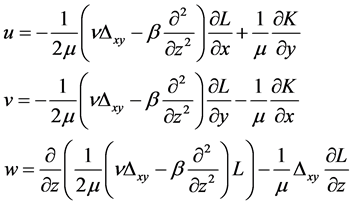Open Access Library Journal
Vol.02 No.07(2015), Article ID:68484,6 pages
10.4236/oalib.1101670
Unidimensional Inhomogeneous Isotropic Elastic Half-Space
Igor Petrovich Dobrovolsky
Institute of Physics of the Earth, Russian Academy of Sciences, Moscow, Russia
Email: dipedip@gmail.com
Copyright © 2015 by author and OALib.
This work is licensed under the Creative Commons Attribution International License (CC BY).
http://creativecommons.org/licenses/by/4.0/


Received 15 June 2015; accepted 1 July 2015; published 8 July 2015

ABSTRACT
The homogeneous system of the equations of the linear theory of elasticity for the isotropic environment with one-dimensional continuous heterogeneity is considered. Bidimensional transformation Fourier is applied and the problem for images is led to the ordinary differential equations. Generally, the differential equations are transformed in integro-differential and the algorithm of such transformation is resulted. Solutions of specific problems are resulted.
Keywords:
Continuous Heterogeneity, The Integro-Differential Equation, Bidimensional Fourier’s Transformation
Subject Areas: Geophysics

1. Introduction
The elastic half-space is considered inhomogeneous along depth. Such problems were investigated in many works (for example, [1] - [3] ). The detailed review is not the purpose of this paper, but the technique applied in the paper does not meet in publications. Let’s note that problems for an elastic half-space are especially important in a science about the Earth as the Earth’s crust is usually modelled by a half-space.
Research is made with application of bidimensional transformation Fourier which leads to the ordinary differential equations. The method of transition to integral equations [4] is applied to their solution. Such technique expands a circle of problems for which it is possible to find the satisfactory approached solution. The concrete example is resulted.
2. Statement of the Problem
In cartesian coordinates (x, y, z) it is considered isotropic inhomogeneous on z an elastic half-space z ≥ 0 with the shear modulus μ(z) and coefficient of Poisson ν(z). In this case the homogeneous system of the equations of the theory of elasticity in displacements (u, v, w) looks like
 (2.1)
(2.1)
where  is a volume strain, ω = 1 − 2ν, Δ is Laplace operator on three variables, the comma in an inferior index means a derivative on corresponding variable.
is a volume strain, ω = 1 − 2ν, Δ is Laplace operator on three variables, the comma in an inferior index means a derivative on corresponding variable.
In [5] it is shown, that the system (2.1) is equivalent to system for two functions
 (2.2)
(2.2)
where η = d(lnμ)/dz. β = 1 − ν, Δxy is Laplace operator on two variables.
Displacements are expressed by formulas
 (2.3)
(2.3)
and stresses are

 . (2.4)
. (2.4)
Formulas (2.1)-(2.4) are received in the monograph [5] . Here it have undergone to some transformations.
To a half-space (or a lay) we shall apply bidimensional transformation Fourier in the form of
 (2.5)
(2.5)
where i is imaginary unit.
Then the basic operators will be transformed by formulas
 . (2.6)
. (2.6)
For functions  and
and  the system (2.2) gets an aspect
the system (2.2) gets an aspect
 . (2.7)
. (2.7)
Transformations of stresses on a plane z = const are
 . (2.8)
. (2.8)
The problem is reduced to a solution of the ordinary linear differential equations for functions  and
and  with corresponding boundary conditions. The reversion of transformation of Fourier (calculation of definite integrals) does not cause difficulties for modern mathematical programs.
with corresponding boundary conditions. The reversion of transformation of Fourier (calculation of definite integrals) does not cause difficulties for modern mathematical programs.
3. The Equation for 
The first equation from (2.7) we will write down in a kind
 . (3.1)
. (3.1)
One of ways of search of the approached the general solution of the Equation (3.1) for any smooth function μ(z) is transition to the integro-differential equation on algorithm [4] . In so doing an operator  is chosen by the basic operator, because for a homogeneous environment (μ = const) the Equation (3.1) has form
is chosen by the basic operator, because for a homogeneous environment (μ = const) the Equation (3.1) has form
For a finite segment we use the general solution of the inhomogeneous equation


It allows to construct the equation for a semi-infinite segment.
As a result we come to two integro-differential equations of the II kind:
for layer

and for a half-space

By integration by parts (3.3) and (3.4) will be transformed to integral equations


If for the equation 
4. The Equation for
Let’s note the second equation of system (2.7) in the form

where
If to apply to the Equation (4.1) operator, inverse to
For a layer

And for a half-space

At μ = 1/(az+b) function Q(z) = 0 and Formulas (4.2) and (4.3) give the exact general solution of the equation (4.1).
5. Solution of the Specific Problem
We shall consider a problem about unit force on a surface of a half-space z ≥ 0 in the origin of coordinates. Apparently from system (2.8), in this case (and, in general, for problems with axial symmetry) it is possible to put 


Let’s put

Then the Equation (4.1) has the solution limited on infinity

Here C1 and C2 are arbitrary constants, ζ = ρ(1 + z), Ψ(α, β; x) is degenerate hypergeometric function of 2-nd sort or Kummer’s function of 2-nd kind. In computer program Maple this function is designated as Kummer U (α, β, z) and it has integral representation

where Γ(a) is the gamma-function.
It is simple to receive the solution of the problem (5.1)-(5.3) in Fourier transformations, but to carry out the inverse Fourier transform through known functions is not receive. However it is possible to approximate special functions by combinations of elementary functions. Approximation can be made with a demanded exactitude and simplifies the further calculations. In particular for (5.3) we have

The error of this approximation does not exceed 0.5 %.
Level lines of stress σzz are shown on Figure 1. The narrow layer at the half-space surface is empty because it is necessary to show it in larger scale though qualitative behaviour of level lines in this layer to present simply. Existence of a zone of small tensile stresses is the basic singularity of this graph. In a homogeneous half-space
Figure 1. Level lines of stress the exact σzz solution. Black area is the zone of positive values.
(the Boussinesq’s problem) such zone does not arise.
It is interesting to compare the received solution to the approximate solution. As the approximate solution we take the zero approximation for the Equation (4.3). Such solution turns out at Q = 0 and it has the form

Using boundary conditions (5.1) we receive function

According to (2.8) transformation of stress σzz gets the form

To receive stress σzz it is necessary to calculate integral

where 

To calculate (5.9) we will allocate the whole part in the integrand.

The integral (5.9) is calculated in elementary functions for first three items from a right part of (5.10). The fourth item leads to the integral

which is not expressed in known functions.
However by means of approximation

integral (5.11) also can be calculated in elementary functions. This operation is easily supervised because the integral (5.11) can be found in separate points numerically by means of known mathematical programs (for example, Maple or Mathematica).
Level lines of stress σzz calculated by the described algorithm are shown on Figure 2. Figure 1 and Figure 2
Figure 2. Level lines of stress σzz. The approximate solution.
basically are similar. In the approximate solution the area of small tensile stresses remains but it becomes more extensive and moves further from an origin of coordinates.
6. Conclusion
Transition to integro-differential (or integral) equations is an effective method of a solution of problems for a half-space (or a layer) with arbitrary heterogeneity. It is very important that the solution of an integral equation gives the approximate general solution of the ordinary differential equation. Procedure of transition to integro- differential (or integral) equations allows constructing such equations for the inhomogeneous differential equations.
Cite this paper
Igor Petrovich Dobrovolsky, (2015) Unidimensional Inhomogeneous Isotropic Elastic Half-Space. Open Access Library Journal,02,1-6. doi: 10.4236/oalib.1101670
References
- 1. Gibson, R.E. (1967) Some Results Concerning Displacements and Stresses in a Nonhomogeneous Elastic Half-Space. Geotechnique, 17, 58-67.
http://dx.doi.org/10.1680/geot.1967.17.1.58 - 2. Brown, P.T. and Gibson, R.E. (1979) Surface Settlement of a Finite Elastic Layer Whose Modulus Increases Linearly with Depth. International Journal for Numerical and Analytical Methods in Geomechanics, 3, 33-47.
http://dx.doi.org/10.1002/nag.1610030105 - 3. Guler, M.A. and Erdogan, F. (2004) Contact Mechanics of Graded Coatings. International Journal of Solids and Structures, 41, 3865-3889.
http://dx.doi.org/10.1016/j.ijsolstr.2004.02.025 - 4. Dobrovolsky, I.P. (2014) The Integral Equation, Corresponding to the Ordinary Differential Equation. Open Access Library Journal, 1, e1058.
http://dx.doi.org/10.4236/oalib.1101058 - 5. Lomakin, V.A. (1976) The Elasticity Theory of Inhomogeneous Solid. The Moscow Univercity, Moscow, 368 p.
- 6. Kamke, E. (1959) Differential Gleichungen. Lösungsmetohden und Losungen. Leipzig.




